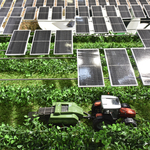
Intersolar Europe: Agrivoltaics – Harvesting Solar Power
MUNICH & PFORZHEIM, Germany–(BUSINESS WIRE)–The world population is growing, as is the demand for food. To tackle the climate crisis, the world needs both agricultural land and surfaces for the deployment of photovoltaics (PV). In line with the zeitgeist, agricultural PV brings together both worlds: agriculture and renewable power generation. Solar modules built over fields can transport us into the new energy world faster, all the while protecting important agricultural yields. This is why Intersolar Europe – The world’s leading exhibition for the solar industry – will be focusing on the topic. Together with the French-German Office for Energy Transition (DFBEW), Intersolar Europe will be presenting new business models and best practices from France and Germany. Agricultural PV is also on the agenda of the Intersolar Europe Conference. Intersolar Europe will be held as part of The smarter E Europe, the continent’s largest platform for the energy industry, from June 14 to 16, 2023 in Munich.
Agrivoltaics is currently trending. Agrivoltaics projects are demonstrating how the generation of solar power and agriculture can go hand in hand and benefit from each other and how the conflict over available surfaces can be cleverly solved.
Renewable electricity for decentralized self-consumption is a great opportunity for agricultural operations adding solar installations to their assets. It allows them to use the renewable power generated on their land and reduce their bills for grid-supplied electricity. If they have excess electricity, they can sell it, which provides an additional source of income. What’s more, agricultural PV installations can boost resilience and increase the yield of agricultural operations because solar modules offer protection against heavy rain, hail or drought for fruit and special crops.
Europe recognizes potential
In many European countries, more and more farmers and political decision-makers are recognizing the potential of agricultural PV. Italy, for instance, recently passed new regulations that determine which agricultural PV installations are eligible for funding from a government incentive program with a scope of 1.1 billion euros, giving a boost to innovative agricultural PV installations. While Germany is testing agricultural PV in combination with the cultivation of apples, for example, in Gelsdorf in Rhineland Palatinate, France has started installing solar modules over rows of vines.
With tractor and tracker – trend towards dual use
Covering crops with raised solar modules – as French winegrowers are doing now – is particularly interesting because it is favorable for winegrowing, as well as for fruit, berries or herbs, and any plants that prefer partial shade. Furthermore, solar roofs can replace conventional hail netting or polytunnels, and they protect the crops from drying out.
Integrating solar installations into agriculture opens up many areas of application. Free-standing solar installations on fields and meadows can also be equipped with trackers that follow the course of the sun, which increases the yield compared with conventional, fixed modules, by around 20 percent. The solar panels can also be moved out of the way of any working agricultural machinery.
Agri PV: Hot topic at Intersolar Europe
To learn all there is to know about solar power generation in agriculture, join us at Intersolar Europe. The session “Agricultural PV in France and Germany: Potential, Business Models and Best Practice” (Agri-PV in Deutschland und Frankreich: Potenziale, Geschäftsmodelle und Best Practices) on June 15 at 3:20pm CEST at the Intersolar Forum will be presenting an extensive overview of solutions and applications that already work. An even more hands-on experience will be offered by many exhibitors, such as BayWa r.e. AG, Fraunhofer Institute for Solar Energy Systems (ISE), Next2Sun GmbH, Goldbeck Solar GmbH, SunFarming GmbH and many more. The program of the Intersolar Europe Conference will be looking into agricultural PV one day before the start of the exhibition itself. Experts will be discussing the potential of solar power in agriculture.
Intersolar Europe will be held from June 14–16, 2023 as part of The smarter E Europe 2023 at Messe München. Over 85,000 visitors from all corners of the globe are expected to attend. More than 2,200 exhibitors across 17 exhibition halls covering 180,000 square meters will be waiting for them.
Contacts
Peggy Zilay
Spokesperson
The smarter E Europe
+49 7231 58598-240
Juliane Heermeier
Account Manager
+49 151 41482446

